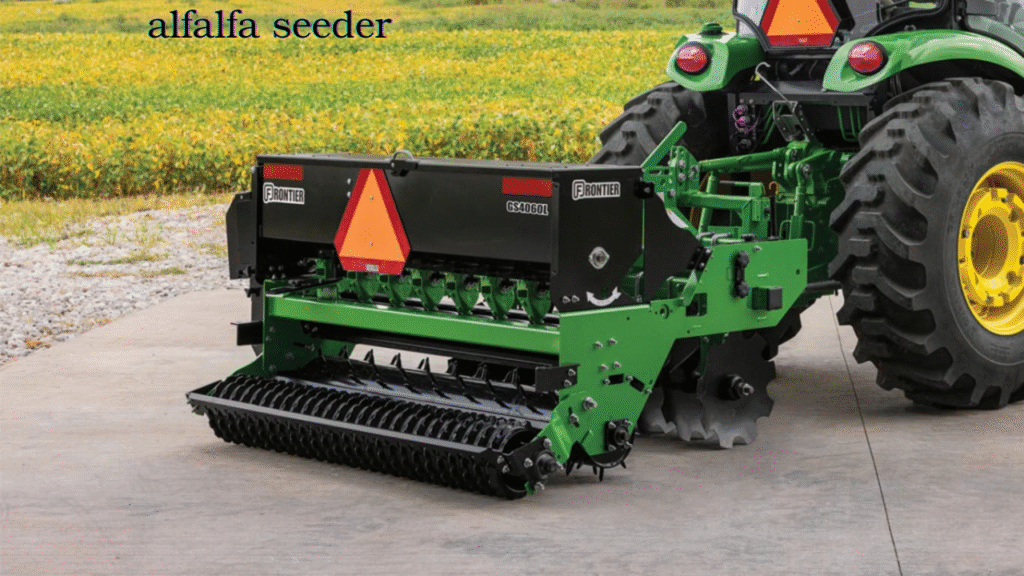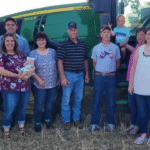Alfalfa, often called the “Queen of Forages,” is a highly nutritious crop vital for livestock feed worldwide. To achieve a healthy and productive alfalfa stand, precise planting is essential. This is where an alfalfa seeder becomes an invaluable tool. An alfalfa seeder is a specialized machine designed to plant alfalfa seeds uniformly and at the right depth, ensuring optimal germination and growth. Unlike general seed drills, alfalfa seeders are tailored to handle the tiny, delicate seeds of alfalfa, minimizing seed damage and maximizing yield potential.
Using an alfalfa seeder improves planting efficiency by delivering consistent seed spacing and depth, which are crucial for uniform crop emergence. A uniform stand not only boosts yield but also makes weed control and harvesting easier. Additionally, an appropriate seeder helps reduce seed wastage, lowering overall input costs for farmers. Understanding the types and mechanics of alfalfa seeders allows growers to select the right equipment suited for their land and farming practices, ultimately improving productivity and profitability.
Alfalfa seeders have evolved significantly over time, incorporating technological innovations that enhance precision and ease of use. As a result, modern seeders support sustainable farming practices by promoting better seed-to-soil contact and reducing soil disturbance. This comprehensive guide will explore everything from seeder types to best planting practices, helping farmers master alfalfa seeding for maximum crop success.
Types and Features of Alfalfa Seeders
When it comes to planting alfalfa, farmers have two primary seeder types to consider: drill seeders and broadcast seeders. Drill seeders place seeds directly into the soil in neat rows, ensuring precise depth and spacing. This method promotes strong root establishment and efficient use of nutrients. In contrast, broadcast seeders scatter seeds across the soil surface, which is less precise and often requires additional steps like harrowing to cover the seeds. For alfalfa, which requires careful seed placement to prevent waste and ensure germination, drill seeders are generally preferred.
The typical alfalfa seeder consists of several key components that work together to plant seeds accurately. These include seed boxes that hold the seeds, metering systems that control seed flow, coulters or discs that open the soil, and press wheels that firm the soil over the seed. Each part plays a critical role in maintaining seed spacing, depth, and soil contact. Modern seeders often feature adjustable settings to customize seeding depth and seed rate based on specific crop needs and soil types.
Technological advancements have further revolutionized alfalfa seeding. Today, many seeders integrate GPS guidance systems and variable rate seeding technology. These features allow for precise navigation of fields and the ability to adjust seed rates dynamically based on soil fertility maps, resulting in optimized seeding efficiency. Some advanced seeders also come with seed monitoring systems that alert operators to blockages or seed shortages, minimizing downtime and improving accuracy.
Choosing the right seeder depends largely on farm size, soil conditions, and budget. For small to medium farms, a reliable drill seeder with adjustable features may suffice. Larger operations may benefit from high-tech seeders equipped with GPS and automatic controls to maximize efficiency. Regardless of type, understanding the features and capabilities of your alfalfa seeder is essential for achieving optimal results.
How to Use an Alfalfa Seeder Effectively
Before planting alfalfa, proper field preparation is key to ensure the seed can germinate and grow well. Soil should be tested and amended as needed to achieve the ideal pH and nutrient levels for alfalfa. Tillage may be required to break up compacted soil and remove weeds, creating a smooth seedbed. However, minimizing excessive soil disturbance is important to retain moisture and organic matter. A well-prepared seedbed allows the seeder to place seeds evenly at the correct depth, promoting uniform emergence.
Setting up the alfalfa seeder correctly is crucial. Begin by calibrating the seed metering system to deliver the recommended seed rate, usually between 12 to 20 pounds per acre, depending on soil and climate. Adjust the depth control mechanisms to place seeds about ¼ to ½ inch deep—too shallow and seeds may dry out; too deep and seedlings may struggle to emerge. Checking calibration regularly during seeding helps maintain accuracy.
During seeding, ensure the seeder maintains consistent speed to avoid uneven planting. Operators should monitor seed flow and soil contact to avoid gaps or clumps. Good seed-to-soil contact improves moisture absorption, critical for early germination. Some seeders are equipped with press wheels or rollers to firm the soil over the seed, enhancing contact.
Timing is another important factor. The best time to seed alfalfa depends on the local climate but generally falls in early spring or late summer when soil temperatures reach at least 50°F. Planting during these periods reduces the risk of frost damage and supports quick seedling establishment before harsh weather sets in. Proper timing combined with careful seeding practices sets the stage for a strong, productive alfalfa crop.
Maintenance and Troubleshooting of Alfalfa Seeders

To keep an alfalfa seeder working optimally season after season, routine maintenance is essential. Begin with cleaning the machine thoroughly after each use to remove seed residue, dust, and soil that can clog moving parts. Lubricate chains, bearings, and other mechanical components as recommended by the manufacturer to prevent rust and wear. Regularly inspect seed tubes, metering mechanisms, and coulters for damage or blockage.
Common problems during alfalfa seeding include uneven seed distribution, clogging of seed tubes, and improper seed depth. Uneven seed flow often results from clogged or worn metering plates, which may need cleaning or replacement. If seeds are being planted too shallow or too deep, recheck the depth control settings and make adjustments. Monitoring the seeder during operation allows quick identification of such issues, minimizing seed waste and ensuring crop uniformity.
After the seeding season, store the alfalfa seeder in a dry, sheltered location to protect it from moisture and corrosion. Cover the machine if possible and disconnect any electronic components for safekeeping. Keep essential spare parts on hand, such as extra seed plates, coulters, and bearings, to enable quick repairs when needed. Following a regular maintenance schedule not only extends the life of your equipment but also ensures consistent, high-quality planting every season.
Benefits of Using an Alfalfa Seeder Yield and Cost Efficiency
Utilizing an alfalfa seeder significantly improves germination rates and crop establishment compared to manual or broadcast seeding. Precise seed placement ensures each seed has adequate space and resources to grow, reducing competition and improving plant vigor. A uniform stand also facilitates easier weed control and harvest, further enhancing overall crop performance.
In terms of cost, an alfalfa seeder reduces seed wastage by placing seeds exactly where needed, rather than scattering them haphazardly. This efficiency translates to lower seed costs and better use of inputs such as fertilizer and water. Additionally, efficient planting shortens the time needed for fieldwork, lowering labor and fuel expenses.
From an environmental perspective, alfalfa seeders promote soil conservation by minimizing disturbance and maintaining ground cover. Better seed-to-soil contact reduces erosion risk and encourages healthy root systems, improving soil structure over time. Many farmers report higher yields and profitability after switching to specialized alfalfa seeders, with some even citing improved soil health as a long-term benefit.
Conclusion
Selecting and using the right alfalfa seeder is a vital step toward successful alfalfa production. Precision planting not only enhances seed germination and crop uniformity but also reduces seed wastage and input costs. Understanding the features of different seeders, proper field preparation, correct seeder calibration, and regular maintenance all contribute to maximizing the benefits of this essential equipment. By mastering alfalfa seeding techniques, farmers can improve yields, profitability, and sustainability on their farms.
FAQs
What is the difference between an alfalfa seeder and a regular seed drill?
An alfalfa seeder is specifically designed to handle small, delicate alfalfa seeds with precise spacing and depth control, while regular seed drills are more general-purpose and may not provide the same level of accuracy or seed protection.
Can an alfalfa seeder be used for other types of seeds?
Yes, many alfalfa seeders can plant other small seeds, but adjustments may be needed for seed size and depth. Always check the manufacturer’s guidelines before switching seed types.
How often should I calibrate my alfalfa seeder?
Calibration should be done before each planting session and periodically during seeding to maintain accuracy.
What is the ideal seed depth for planting alfalfa?
Typically, alfalfa seeds should be planted between ¼ inch and ½ inch deep for optimal germination.
How do weather conditions affect alfalfa seeding?
Soil temperature and moisture levels are critical. Planting in too cold or dry conditions can delay germination or reduce seedling survival.
You May Also Read: https://techbusinessus.com/jennifer-kiel/





